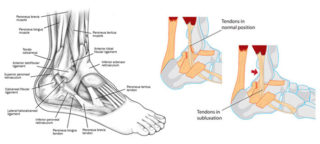

The Achilles tendon connects the calf muscle to the heel bone. It lets you rise up on your toes and push off when you walk or run. Problems with the Achilles tendon may seem to happen suddenly. But usually they are the result of many tiny tears to the tendon that have happened over time.
The following is a list of common Achilles tendon issues :
The Achilles tendon is the largest tendon in the human body and can withstand forces of 1,000 pounds or more. But it also the most frequently ruptured tendon.
Both professional and weekend athletes can suffer from Achilles tendinitis, a common overuse injury and inflammation of the tendon.

Events that can cause Achilles tendinitis may include:
Achilles tendinitis often begins with mild pain after exercise or running that gradually worsens.
Other symptoms include:
Treatment normally includes:
In extreme cases, surgery is performed to remove the fibrous tissue and repair any tears.
Personal tendons originate outside of the calves and have two tendons muscle name Peroneus Brevis and Peroneus Longus. While standing these two muscles help you to roll to the outside of the foot.
It’s also called as stirrup tendons as it help hold up the arch of the foot. With the help of band of tissue called the peroneal retinaculum muscles are held in place. If retinaculum got injury it can cause to stretch or even tear. In such case peroneal tendons can dislocate from their groove on the back of the fibula. Tendons can be seen to roll over the outside of the fibula, damaging the tendons.

Cause :
The most common sports activities that can cause peroneal tendon dislocation are snow skiing, football, basketball, and soccer. Ankle sprains can also lead to such condition.
Treatment :
It’s interesting orthopaedic condition that occurs rarely. This is associated with disturbance of lipid metabolism.
Because of high cholesterol level small lumps in the Achilles tendon are found. Cholesterol is deposits in the tendon itself. In such case we have to get treatment for both cholesterol as well as Xanthomas which involves taking a biopsy of the lesion but leaving the nodules intact.

It may also involve adjacent ligament, fascia or periosteum. Achilles tendons and patellar tendons may also be involved. Lesion may affect the tendon of the triceps or the extensor tendons of the toes. Lesions only develop in patients with the hereditary form of hypercholesteremia. Number and size of lesions are directly related to cholesterol level and the age of the individual.